Black nightshade: poisonous or not, what properties does it have?
Among the poisonous plants, there are those that can be eaten, used for medicinal purposes, observing the rules of admission. The Solanaceae family is represented by many crops in our garden. It is not surprising that black nightshade is a close relative of tomatoes, potatoes, and peppers. Who does not know the black berries of the plant, which are called crow, wolf berries or bzdnik. They are eaten, they even make jam out of them. But many nightshades are poisonous.
Species nightshade there are more than a thousand in the world. In addition to cultivated plant species, there are many wild ones. Close relatives look like grasses, shrubs, trees. Their stem can spread along the ground or stand upright. The leaves of the Solanaceae have both a simple shape and are cut into pieces. Flowers vary in color from white to pink to purple, depending on the type of plant. Over time, the inflorescences turn into fruits shaped like berries. But, despite the beauty of the appearance, many plants of the Solanaceae family are poisonous.
Content:
- Is the black nightshade poisonous or not?
- What beneficial properties does it have?
- Where and how is it used?
- Harm and contraindications
- Collecting, harvesting and storage of nightshade
Is black nightshade poisonous?
Annual plant black nightshade, or ordinary, reaches a height of 70 centimeters. Its stem is straight and slightly pubescent. There are leaves on long petioles. They are either solid in shape or serrated at the edges. From June to September, small white flowers, collected in umbrellas, appear on drooping pedicels.
From July to early autumn, fruits appear on the stems - black, juicy berries, rounded in shape. While the fruits are green, they are poisonous. As the berries ripen, the toxic substance solanine in berries loses its toxic effect. You can safely eat black fruits with a lot of yellowish seeds inside. The toxicity of nightshade is known to everyone, therefore, for medicinal purposes, the leaves, flowers are used under the supervision of a doctor. There are no harmful substances in black berries, but you should not get carried away with their use unnecessarily.
All parts of the plant are poisonous, except for ripe, juicy berries.
The homeland of the black nightshade is considered the warm regions of the Mediterranean. It can now be found in abundance everywhere. On the banks of reservoirs, near the roads, bushes covered with black berries are met. In gardens and in the fields, they try to get rid of nightshade like weeds. In the south of Europe, in Central Asia, in the Caucasus, in Siberia, this unpretentious plant is found. It grows well in poor soils.
Spreading through seeds, black nightshade fills wastelands. It multiplies rapidly and grows on sunny slopes. The plant is not afraid of the cold winter, therefore it has spread to areas with a temperate climate. An annual plant is not found only in Kazakhstan because of the arid climate. Black nightshade grows everywhere, but few people know about the beneficial properties of the plant. A person walks by, not paying attention to the source of vitamins and minerals.
What beneficial properties does it have?
Nightshade black deservedly enjoyed the attention of doctors of antiquity.It was used as a narcotic and pain reliever before surgery. He saved from a severe headache.
Parts of the plant rich in trace elements and vitamins will help:
- calm down with nervous excitement, epilepsy, convulsions
- improve the menstrual cycle in women
- in the treatment of bronchial asthma, cystitis, gastritis
- dissolve swelling, accelerate the maturation of abscesses
- relieve inflammation of the skin, mucous membranes of the mouth, throat
As part of nightshade, calcium, which has a beneficial effect on the state of the skeletal system, strengthens the heart and blood vessels. To prevent kidney stones, normalize the functions of the digestive tract, magnesium is needed, which is abundant in nightshade.
Glycosides neutralize the action of pathogenic bacteria on the body, and rutin is needed to reduce the pressure in the vessels. The role of organic acids is to eliminate toxins and break down fats. All preparations based on black nightshade are beneficial, provided they are correctly dosed and adherence to the regimen.
Where and how is it used?
In folk medicine, the aerial part of the black nightshade is widely used:
- The flowers of the plant are characterized by a diuretic and expectorant effect. With rheumatism, one teaspoon of flowers is poured with 250 milliliters of boiling water and insisted for two hours. Drink a tablespoon three times a day.
- Leaves applied to purulent wounds and ulcers can quickly heal the affected areas. Fresh and dry leaves, pre-soaked, help the maturation of purulent abscesses, the elimination of hemorrhoids.
- Leaf compresses soothe headaches by applying them to the temples.
- An infusion is prepared from the leaves (two teaspoons of raw materials per liter of boiling water). Take a tablespoon four times a day to soothe headaches, stomach cramps, bladder cramps, itching of the skin.
- For washing purulent wounds, use an infusion prepared from eight tablespoons of black nightshade leaves for two liters of boiling water. It is necessary to insist the medicine for three to four hours. Use such an infusion for sitz baths for hemorrhoids.
- Ripe nightshade berries are consumed fresh to relieve inflammation in the oral cavity.
- Infusion of fruits in the amount of 50 milliliters can easily cleanse the body of toxins. A medicine is prepared from two to three tablespoons of berries per 250 milliliters of hot water. The infusion should not be taken in large quantities, as it promotes increased gas production.
- Berry juice mixed in 100 grams of water (three tablespoons) is used to gargle with sore throat. And with the juice of the leaves they cure a runny nose by instilling two or three drops into the nose.
- Like nightshade leaves, black berries mixed with sour milk help heal ulcers, purulent wounds, and abscesses.
Before using black nightshade products in treatment, you should consult your doctor. Ripe berries of the plant are used in cooking as a filling for pies; they are used to make delicious preserves and jams. Previously, berries were used to make dyes. And now the black nightshade is not forgotten by traditional healers, they prepare useful preparations from it.
Harm and contraindications
Besides the benefits nightshade can be harmful if misused. Poisoning from unripe berries and leaves will seriously affect human health. The patient has shortness of breath, vomiting, depression of the psyche and physical activity.
Help should be provided in time for nightshade poisoning: rinse the stomach, giving the patient activated charcoal or 1% potassium permanganate solution. Be sure to call an ambulance, because poisoning can even lead to death with a rapid accumulation of poison in the body.
It is forbidden to take funds from black nightshade for those who have impaired functions of the pancreas and liver.
You can not use the berries of the plant for people with low blood pressure, vegetative-vascular dystonia. Women during pregnancy and lactation are also prohibited from drugs based on black nightshade.Given the healing properties of the plant, one must be careful about the use of the nightshade berries. This is especially true for children.
Collecting, harvesting and storage of nightshade
Leaves, flowers of the plant are harvested from July to September, when the bushes are covered with white umbrellas of white corollas. Raw materials are laid out under a canopy or in a ventilated area. During drying, they try to constantly stir up the plant mass, then it dries better.
The fruits are best harvested in October, when they are fully ripe. The dried pieces of nightshade are laid out in boxes lined with tissue paper and stored in a dark place. You can use plant material for eight years - it will not lose its medicinal properties.
The high content of carotene and ascorbic acid in berries makes it possible to make jam from nightshade.
The product is cooked as usual with the addition of sugar and citric acid. You can dry the fruits, so that later you can prepare compotes, jelly from them and use them as a filling for pies, dumplings. From the age of three, children are given this tasty and healthy product that benefits.
It is necessary to harvest the leaves and flowers of black nightshade on time, so that in infusions they will help in the treatment of diseases. And the fruits are harvested, paying attention to the juiciness of the color of the fruit. Unripe berries are not left behind, because they contain a lot of poisonous solanine.
More information can be found in the video:



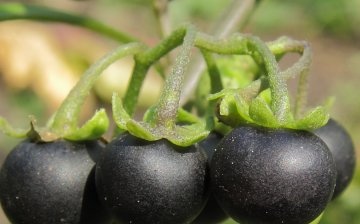
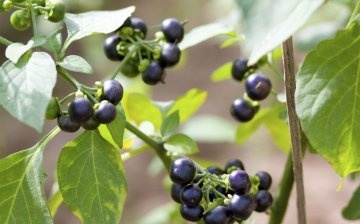
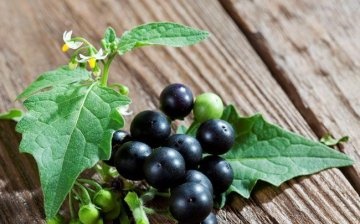
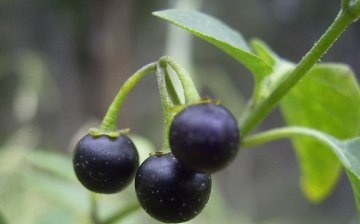








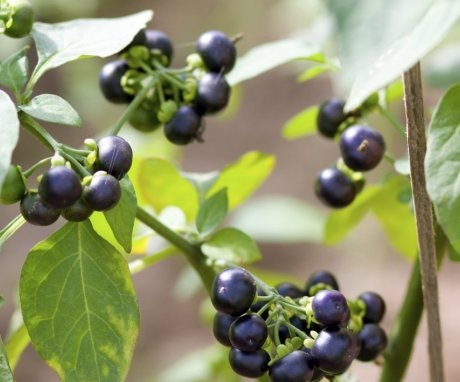



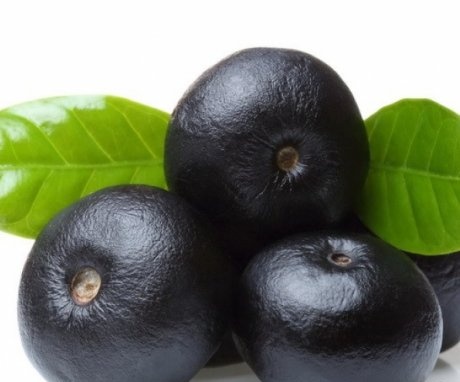
If a lot of black nightshade bushes grow in the garden, then after picking up ripe black berries, I make jam from them. Green berries cannot be eaten, as you can get poisoned. The main thing is not to confuse nightshade with wolfberry, although those berries are red.
During our carefree childhood, what kind of plants we have not tasted. The nightshade was no exception, although my grandmother frightened us with various consequences, but I did not know about the beneficial properties of the plant.